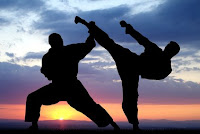Practicing Creating Conflict
 How counterintuitive is that? Practicing how you can create conflict in a group process? Most people, and certainly most facilitators, go to great lengths to avoid conflict, seeing it as counterproductive to achieving some task.
How counterintuitive is that? Practicing how you can create conflict in a group process? Most people, and certainly most facilitators, go to great lengths to avoid conflict, seeing it as counterproductive to achieving some task.
Just imagine for a moment that exactly the opposite was true…
This week we are holding a workshop called “Beyond Facilitation: Intervention Skills for Strengthening Groups and Teams.” This is our second year to hold an adapted version of a Group Process Consultation training workshop. I wrote about the first one held last year at our institution in a post called “You have the right to remain silent“.
Playing with creating conflict has become a leitmotiv today, the third of a four-day training course. We started with an organizational simulation called Lego Man. What may look on paper like a simple team building game, actually does a good job of simulating in 90 minutes a full production process, from conception, understanding the task, defining roles and deliverables, creating a strategy for the process and delivery, making some decisions, and then actually assembling the final product (the Lego man) with some standards to adhere to. Interestingly, one of the learning points from this simulation, noted by our lead trainer Chuck Phillips, is that the teams who provoke conflict among their members are the highest performers (measured by time to construct the Lego man).
But what do people think about this notion of precipitating conflict? For the most part, people’s immediate assumptions about conflict is that it is bad – that it is fighting, and it’s personal, and to be avoided at all cost. Because of this, the standard reaction to mounting conflict is to smooth it over, calm it down, or simply ignore it. Team leaders may do this, team members may do this, and facilitators may do this. Everyone may actively take a part in suppressing conflict. But what that response does, it’s suggested, is to rob from a group an opportunity to confront and consider a difference in opinion, approach, or methodology that may in fact be the key to moving successfully to a higher level of performance or understanding.
Of course there are different kinds of conflict. The kind we would want to precipitate would be from bumping up against people’s assumptions and ideas. This is where conflict can get a team to a new and different level, test assumptions, create new options, and as a result potentially come up with a faster, more effective result.
So we practiced today some of the skills needed to start an ideas conflict – to keep it from becoming a fight – and then to help the group guide it to that moment where paradigms shift and new possibilities arrive. That is what we have been doing today – our best to not let our working groups stay too polite.



Leave a Reply
Want to join the discussion?Feel free to contribute!